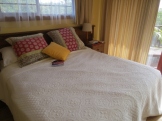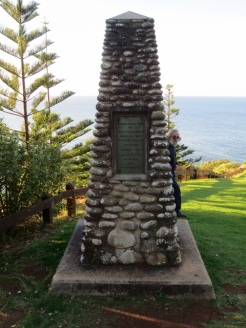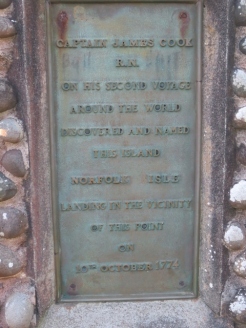Well, we’re off home tomorrow and although I’m looking forward to being home with my friends and my dog and my own house and garden, I’m not looking forward to the fog, which is not actually fog at all but rather particulate pollution caused by stupid people burning trendy log fires when there’s no wind to blow the pollution away. It means I will have to stay indoors until we get a blast of wind from the Antarctic to clear the air.
So that’s been a reminder to appreciate the beautiful clean air here on Norfolk Island. This little Sacred Kingfisher on our verandah likes it here too.

 We had a quiet couple of days for the last of the week. We loafed about with books yesterday, venturing out only for the fabled Fish Fry at dusk which turned out to be a very much over-priced disappointment. It might be nice in warmer weather, and it might be nice if they had a greater variety of fish, but trumpeter and king fish in a limp lukewarm batter self-served with some indifferent salads and a woeful musical accompaniment is not worth $136 for two.
We had a quiet couple of days for the last of the week. We loafed about with books yesterday, venturing out only for the fabled Fish Fry at dusk which turned out to be a very much over-priced disappointment. It might be nice in warmer weather, and it might be nice if they had a greater variety of fish, but trumpeter and king fish in a limp lukewarm batter self-served with some indifferent salads and a woeful musical accompaniment is not worth $136 for two.
But it was yesterday that I noticed something special about the furniture and fittings here at the Jacaranda Cottages. These cottages are really, really nice, with a spacious sitting room and a well-equipped kitchen; a very comfortable king sized bed with a spa in the ensuite; and a beautiful view over the valley from the deck where we had breakfast most mornings. And although there are five cottages on the site, they are very private, especially if you are on the end of the row as we are. But what I hadn’t realised at first, is that all the furniture is handmade out of Norfolk Island Pine on the island by Dave Pitcher’s Joinery, and it’s beautiful.
We had dinner on our last night at Hilli’s Restaurant again. We haven’t been to all the restaurants on the island, but we’d had such a good meal on our first night, that we wanted to go back there again. They don’t have a huge menu or wine list, but everything they do is well done and well-presented and the staff are friendly and efficient.
So all up, a beaut holiday and we’re glad we came!
Thanks to Vanessa and Bookie for hosting us at Jacaranda Cottages, we would recommend this accommodation to anyone looking for a lovely quiet place to stay.






































